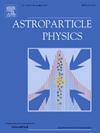Detection limits and trigger rates for ultra-high energy cosmic ray detection with the EUSO-TA ground-based fluorescence telescope
Abstract
EUSO-TA is a ground-based fluorescence telescope built to validate the design of ultra-high energy cosmic ray fluorescence detectors to be operated in space with the technology developed within the Joint Exploratory Missions for Extreme Universe Space Observatory (JEM-EUSO) program. It operates at the Telescope Array (TA) site in Utah, USA. With an external trigger provided by the Black Rock Mesa fluorescence detectors of the Telescope Array experiment, with EUSO-TA we observed air-showers from ultra-high energy cosmic rays, as well as laser events from the Central Laser Facility at the TA site and from portable lasers like the JEM-EUSO Global Light System prototype. Since the Black Rock Mesa fluorescence detectors have a 30 times larger field of view than EUSO-TA, they allow a primary energy reconstruction based on the observation of a large part of the shower evolution, including the shower maximum, while EUSO-TA observes only a part of it, usually far away from the maximum. To estimate the detection limits of EUSO-TA in energy and distance, a method was developed to re-scale their energy, taking into account that EUSO-TA observes only a portion of the air-showers. The method was applied on simulation sets with showers with different primaries, energy, direction, and impact point on the ground, as well as taking into account the experimental environment. EUSO-TA was simulated with an internal trigger and different elevation angles and electronics. The same method was then applied also to real measurements and compared to the simulations. In addition, the method can also be used to estimate the detection limits for experiments that are operated at high altitudes and in most cases can see the maximum of the showers. This was done for EUSO-SPB1, an instrument installed on a super-pressure balloon. Finally, the expected detection rates for EUSO-TA were also assessed using the prepared simulated event sets. The rates correspond to a few detections per recording session of 30 h of observation, depending on the background level and the configuration of the detector.

 求助内容:
求助内容: 应助结果提醒方式:
应助结果提醒方式:


